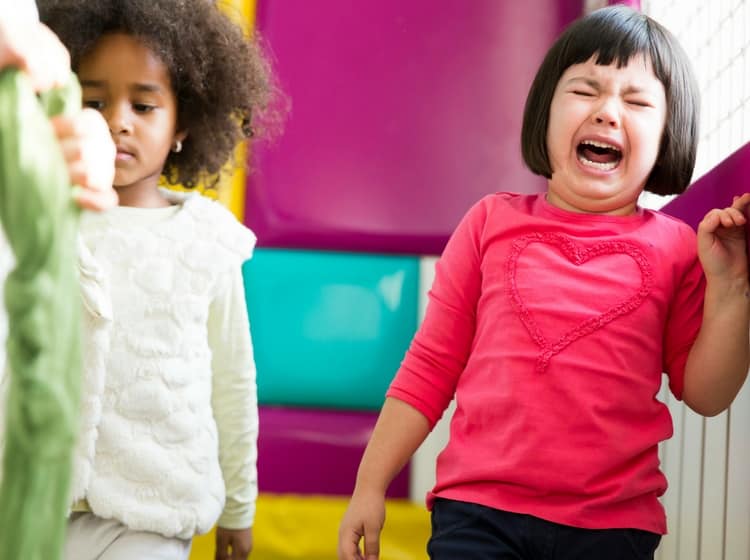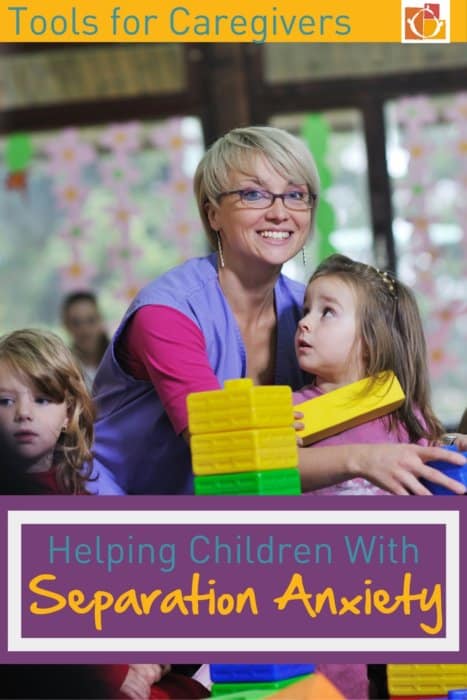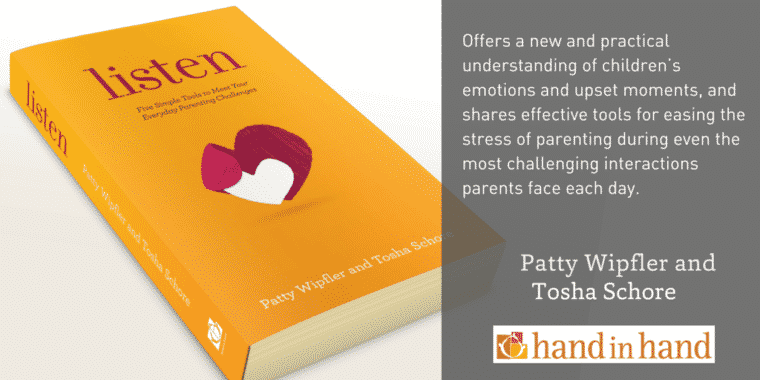![]()
In most daycare and preschools, parents are encouraged to make drop off brief. A quick kiss or hug and then out the door.
But not in Shelley Macy's classes.
She makes efforts to welcome each parent warmly and tries not to rush them. “Warmth is a big deal to a child. They feel connected with you if they feel connected to their parent so building that relationship is important,” she says.
 If children cry, that's ok. Tears don't phase her.
If children cry, that's ok. Tears don't phase her.
“I tell parents, crying is fine, snot is fine with me,” she says. Macy uses a connection childcare tool called Staylistening that lets children confront and work through their fears when they cry. Many times this happens at drop off when separation anxiety commonly kicks in.
Let the Tears Fall
Instead of attempting to stop the tears, Macy will move in, make eye contact, will say very little and lets children get to the end of a cry without intervention.
She offers simple comforts, in a soft voice.
“Daddy will be back this afternoon,” or “Mommy always comes back. I’ll take care of you until she comes,” are examples.
There's no need to name feelings, despite a recent trend to do so, she says.
In fact, the practice can backfire when trying to build a strong connection.
“If you say, “Gee you're mad,” and they really feel sad, they’ll think, “Ahh, this lady doesn’t get me, or this man is off his rocker,” Macy said.
Separation And Disconnection
Often children's unresolved feelings results in them becoming disconnected at school, making it hard for them to focus. Big signals of disconnection include biting, hitting and forcefully hugging, telling others “No, you can't play,” and withdrawal.
And separation anxiety doesn't always happen at drop-off. Even a teacher leaving the room might trigger old, stored up feelings a child has about separation. The arrival of a new staff member or sub-teacher may cause a similar reaction.
“What children need in order to shed those feelings is to cry fully and feel the frightened feelings about separation. While they cry, they need the love and caring of someone who offers them warmth and safety,” the teacher says.
“Helping children work through and shed their feelings about separation can have real benefits not just at drop off time but throughout their day,” Macy told teachers and caregivers in a recent online class.
They return to a state of calm, where they happily engage in play and activities.
 Finding Connection
Finding Connection
An early childhood educator since 1972, Macy says she was once an expert in the common tactics used to get children to quiet their tears.
She would distract them by showing them toys, lead them to their best friends, get them involved in the morning's activity, or read to them.
Anything to have them quiet and stuff those feelings back inside, she said.
But then she discovered how valuable connection was to a growing child's brain.
How children's brains are wired to engage in adult communication, and how that attention aids children's openness to learning.
She went on to learn Hand in Hand Parenting tools for building and re-establishing connection.
The results were inspirational.
In hundreds of instances, she says, she has seen how children become more confident, cooperative and resilient in class when they are listened to.
Children's' biggest, noisiest feelings happen when the brain's prefrontal cortex shuts down.
Reasoning can't reach kids at those times and telling them “Shush,” “Calm down,” or “Don't cry,” only means the feelings resurface when something triggers them later.
A cry or tantrum helps kids resolve the feelings holding them back.
Connection Tools
Macy also talked about using all of the approach's five listening tools to help with separation anxiety.
That includes Special Time, where a caregiver spends a few minutes engaging one-on-one time with a student, and Playlistening, where kids direct play with the caregiver, either singly or in groups.
She also advised setting up Caregiver Listening Time where teachers arrange a time to listen to each other about the feelings they have around crying. Talking about how crying triggers caregiver emotions makes it easier to listen to the children. “Adults didn’t listen to us in this way. This alarm will go off in peoples minds and in our own uncertainty,” she said.
Moving On
The rewards are worth it. When separation anxiety is worked through with warmth and a listening ear, children connect in class and learn well.
“They feel closer to the caregiver that listened to them, they become closer to their parents because they don’t feel abandoned anymore, they stop the off-track behaviours that were spoiling their relationships, and their self-regulation blossoms,” Macy says.
Children become happier, more willing learners.
From the Hand in Hand Toolbox:
Go here to listen to the full replay Shelly Macy hosted on using listening tools to help separation anxiety in childcare settings
Here's the guide she mentions in the replay about separation, causes and cures: Your Ultimate Separation Survival Guide
Read about other teachers using Hand in Hand in schools and daycare
Do you work with families? Listen to How Parenting Triggers Past Hurts and learn science-backed ways you can guide parents past anger and frustration.
Find out about our Professionals Intensive courses for teachers and caregivers

